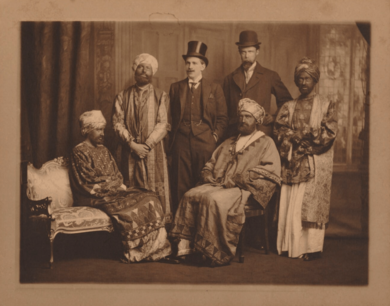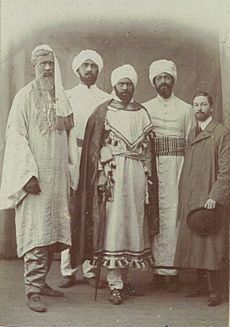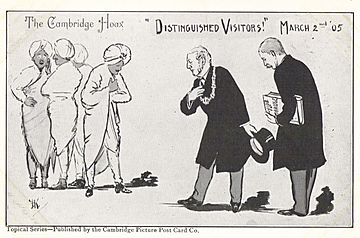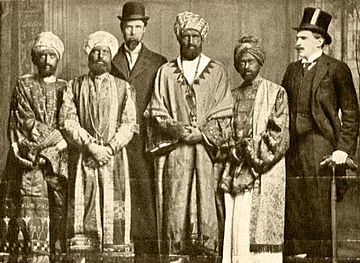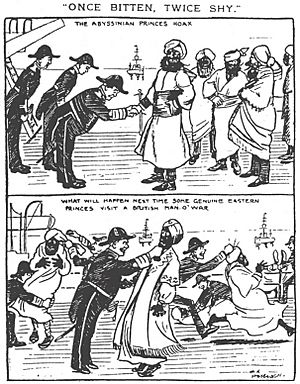Dreadnought hoax facts for kids
The Dreadnought hoax was a famous prank carried out by Horace de Vere Cole in 1910. Cole tricked the Royal Navy, Britain's powerful navy, into believing a group of his friends were "Abyssinian royals". These fake royals were then given a special tour of the battleship HMS Dreadnought, which was the navy's most important ship at the time. This prank also brought attention to a group of writers and artists called the Bloomsbury Group, as some of Cole's friends involved were part of it. Cole had done a similar trick before, in 1905, when he was a student at Cambridge University.
Contents
Who Were the Pranksters?
Horace de Vere Cole: The Prank Master
Horace de Vere Cole was born in Ireland in 1881. His family was quite wealthy. He joined the army and fought in the Second Boer War, where he was badly hurt and had to leave the service. When he came back to Britain, he went to Trinity College, Cambridge university. He didn't study much. Instead, he spent his time having fun and planning many hoaxes and pranks.
One of Cole's best friends at Trinity College was Adrian Stephen. Adrian was good at sports and acting. People who wrote about Cole say that Adrian was perfect for Cole. He was supportive and encouraging, but also brave enough to challenge Cole. Adrian Stephen's father was a famous writer, and his mother was known for her charity work. Adrian's older brother, Thoby Stephen, also went to Trinity. Their sisters, Vanessa (who later became Vanessa Bell) and Virginia (who later became Virginia Woolf), would visit them. After university, the four Stephen siblings became part of the Bloomsbury Group. This was a group of writers, thinkers, and artists. Many of them had also studied at Trinity College. Cole was sometimes around this group, but he was never a full member.
The Cambridge Zanzibar Prank of 1905
In 1905, while they were in their second year at Trinity College, Cambridge, Cole and Adrian Stephen decided to play a trick. They heard that Sayyid Ali bin Hamud Al-Busaid, the Sultan of Zanzibar, was visiting England. They planned to fake a state visit of the sultan to Cambridge. They realized that the sultan's picture had been in the newspapers. So, they decided Cole would pretend to be the sultan's uncle instead of the sultan himself.
On March 2, they sent a telegram to the Mayor of Cambridge. They asked him to arrange a special welcome for the sultan. The telegram said the "Sultan of Zanzibar" would arrive that day at 4:27 PM for a short visit. It asked if the mayor could show him interesting buildings and send a carriage.
The students got special robes and turbans from a costume shop. They also put on dark makeup to change their skin color. Then, they took a train from London. A carriage met them at Cambridge railway station. It took them to the guildhall, where the mayor and town clerk greeted them. After a short welcome, they were taken on a tour of the town. This included some of the university's colleges. Some of their friends saw the pranksters but did not recognize them. After less than an hour, the group demanded to be taken back to the station. They did not want to return to London. If they did, they would miss their college curfew at 10:00 PM. So, when they got to the station, they ran out a side exit. They took two hansom cabs to a friend's house, where they changed back into their normal clothes.
The next day, Cole talked to the Daily Mail newspaper about the prank. The story appeared in the paper on March 4, 1905. Local newspapers also reported it. The St James's Gazette called it "a most daring practical joke." The Mayor wanted the students to be expelled from the university. But the Vice-Chancellor, a senior university official, convinced him that expelling them would make the mayor look even worse.
The Mighty Dreadnought Ship
In the early 1900s, Britain's navy was incredibly important. It was seen as a symbol of the country's power and wealth. Britain was often shown as an island nation in books and plays. So, the Royal Navy was seen as the protector of the island. It was the first line of defense. A newspaper article in The Observer in 1909 said that the Royal Navy's strength was "the best security for the world's peace."
HMS Dreadnought was the first of Britain's "dreadnought" class of battleship. It joined the Royal Navy in 1906. The Dreadnought was the most advanced ship ever built at that time. It had better weapons, was faster, and was stronger than any other ship. From the moment it was launched, the ship became a very important symbol. People knew about it from songs and advertisements. When the ship visited London in 1909, about a million people watched it arrive. By 1910, it was a "cultural icon" with huge symbolic meaning. For example, advertisements for Oxo stock cubes said: "Drink OXO and dread nought" (meaning "fear nothing"). A clothing business used the slogan "Dreadnought and wear British clothing." There were even "Dreadnought trams" that looked like battleships, complete with fake guns. For people living in the Edwardian era, the Dreadnought was almost sacred.
In February 1910, the captain of the Dreadnought was Herbert Richmond. Admiral Sir William May was the Commander-in-Chief of the Home Fleet. This meant the Dreadnought was his main ship. Commander Willie Fisher, who was a cousin of the Stephen siblings, was also on the Admiral's staff aboard the Dreadnought.
The Dreadnought Prank Unfolds
In 1940, Virginia Woolf talked about how naval officers in 1910 loved playing practical jokes on each other. She said that the officers of two ships, the Hawke and the Dreadnought, had a rivalry. Cole's friend, who was on the Hawke, asked Cole for help. He said, "You're great at tricking people; couldn't you do something to make fun of the Dreadnought? They need to be taken down a bit. Couldn't you play one of your jokes on them?"
So, Cole and five friends planned the prank. The friends were writer Virginia Stephen (who later became Virginia Woolf), her brother Adrian Stephen, Guy Ridley, Anthony Buxton, and artist Duncan Grant. They went to the same costume shop as before. The shop owner, Willy Clarkson, helped them disguise themselves. They used skin darkeners and turbans to look like members of the Abyssinian royal family. The main problem with their disguises was that the "royals" couldn't eat anything. If they did, their makeup would be ruined. Adrian Stephen pretended to be their "interpreter."
On February 7, 1910, the costume shop's employees visited Woolf's home. They applied the stage makeup to Woolf, Grant, Buxton, and Ridley. Then, they gave them their Eastern robes. A newspaper, the Daily Mirror, claimed they were also wearing £500 worth of jewelry. However, Cole's biographer, Martyn Downer, doubts this amount. None of the people involved in the prank mentioned such expensive jewelry.
A friend of Stephen's sent a telegram to the "C-in-C, Home Fleet." This was the Commander-in-Chief of the ships that defended Britain. The telegram said that "Prince Makalen of Abbysinia" and his group would arrive at 4:20 PM that day in Weymouth. It said the prince wanted to see the Dreadnought and asked for arrangements to meet them. The message was signed "Harding Foreign Office." Cole had found a post office where only women worked. He thought they would be less likely to ask questions about the message. Cole and his group went to London's Paddington station. There, Cole claimed he was "Herbert Cholmondeley" from the Foreign Office. He demanded a special train to Weymouth. The stationmaster arranged a special VIP train car for them.
In Weymouth, the navy welcomed the "princes" with an honour guard. They couldn't find an Abyssinian flag. So, the navy used the flag of Zanzibar instead. They also played Zanzibar's national anthem.
The group then inspected the fleet. To show their thanks, they spoke in a made-up language. It sounded like a mix of Latin and Greek words. They asked for prayer mats and tried to give fake military honors to some of the officers. Commander Fisher, who was on the ship, did not recognize either of his cousins, Adrian Stephen or Virginia Woolf.
When the prank was discovered in London, Horace de Vere Cole, the main person behind it, contacted the newspapers. He sent a photo of the "princes" to the Daily Mirror. The group's peaceful views were seen as embarrassing for the navy. The Royal Navy became a target of jokes for a short time. The navy later wanted Cole to be arrested. However, Cole and his friends had not broken any law. Instead, except for Virginia Woolf, they were given a symbolic whipping by some junior Royal Navy officers.
What Happened Next?
Newspapers reported that during the visit to the Dreadnought, the fake visitors kept shouting "Bunga Bunga!" to show their surprise or thanks. Years later, in 1915, during the First World War, HMS Dreadnought crashed into and sank a German submarine. This was the only time a battleship ever did this. Among the telegrams congratulating the ship, one simply read "BUNGA BUNGA."
A song about the prank was sung in music halls that year. It used the tune of an old song called "The Girl I Left Behind." The lyrics went:
When I went on board a Dreadnought ship
I looked like a costermonger;
They said I was an Abyssinian prince
'Cos I shouted 'Bunga Bunga!'
Thirty years later, in 1940, Virginia Woolf gave talks about the Dreadnought hoax. She spoke to the Rodmell Women's Institute and also to a group called the Memoir Club. The famous writer E. M. Forster was at the Memoir Club talk.


